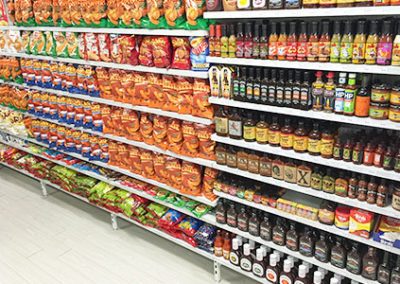The Best Strategy To Use For I Luv Candi
Table of ContentsThe Main Principles Of I Luv Candi Not known Incorrect Statements About I Luv Candi Indicators on I Luv Candi You Need To KnowThe Ultimate Guide To I Luv CandiSee This Report on I Luv Candi
You can likewise approximate your own revenue by using various assumptions with our financial plan for a sweet-shop. Typical month-to-month income: $2,000 This sort of sweet shop is frequently a tiny, family-run service, possibly known to residents yet not bring in big numbers of visitors or passersby. The store might offer a selection of usual sweets and a few homemade deals with.
The store doesn't generally bring uncommon or costly things, focusing instead on affordable treats in order to keep routine sales. Thinking a typical spending of $5 per consumer and around 400 customers per month, the monthly earnings for this sweet-shop would certainly be around. Typical month-to-month earnings: $20,000 This sweet-shop advantages from its tactical place in a hectic urban area, drawing in a multitude of clients searching for sweet indulgences as they shop.

In enhancement to its diverse candy choice, this store could likewise sell relevant products like present baskets, sweet bouquets, and novelty items, giving several profits streams. The shop's area requires a greater allocate rental fee and staffing yet brings about greater sales quantity. With an approximated ordinary spending of $10 per consumer and concerning 2,000 consumers each month, this store might generate.
How I Luv Candi can Save You Time, Stress, and Money.
Situated in a significant city and visitor location, it's a big facility, frequently topped numerous floorings and potentially part of a nationwide or international chain. The store uses a tremendous selection of sweets, including unique and limited-edition products, and goods like branded garments and devices. It's not simply a store; it's a location.
These tourist attractions assist to attract hundreds of site visitors, considerably raising possible sales. The operational costs for this kind of shop are considerable due to the location, dimension, team, and includes supplied. However, the high foot traffic and ordinary spending can cause significant revenue. Presuming an average purchase of $20 per consumer and around 2,500 consumers per month, this front runner store might accomplish.
Group Examples of Expenses Ordinary Month-to-month Cost (Range in $) Tips to Reduce Expenditures Lease and Utilities Shop lease, electrical energy, water, gas $1,500 - $3,500 Think about a smaller area, work out rental fee, and use energy-efficient lights and devices. Stock Candy, snacks, packaging materials $2,000 - $5,000 Optimize inventory management to lower waste and track prominent things to stay clear of overstocking.
Facts About I Luv Candi Uncovered
Advertising And Marketing Printed matter, on-line advertisements, promos $500 - $1,500 Concentrate on cost-effective digital marketing and make use of social media systems free of cost promo. Insurance coverage Company liability insurance policy $100 - $300 Look around for affordable insurance policy rates and think about bundling plans. Tools and Maintenance Sales register, show shelves, repair services $200 - $600 Buy pre-owned devices when feasible and carry out regular maintenance to extend tools life expectancy.

This suggests that the sweet shop has gotten to a point where it covers all its fixed expenditures and begins producing income, we call it the breakeven factor. Think about an example of a sweet-shop where the monthly set prices normally total up to approximately $10,000. A harsh quote for the breakeven factor of a candy shop, would then be about (considering that it's the total set price to cover), or offering in between with a cost series of $2 to $3.33 per system.
I Luv Candi - Truths
A large, well-located sweet shop would clearly have a greater breakeven point than a little shop that does not require much profits to cover their expenditures. Interested regarding the profitability of your sweet-shop? Try our straightforward economic plan crafted for sweet shops. Simply input your very own presumptions, and it will help you compute the amount you require to make in order to run a lucrative business - lolly shop maroochydore.
One more threat is competition from various other candy stores or larger retailers that may offer a broader variety of products at lower rates (https://www.pageorama.com/?p=iluvcandiau). Seasonal changes in need, like a decrease in sales after holidays, can also influence profitability. Additionally, changing customer preferences for healthier treats or nutritional constraints can lower the charm of conventional sweets
Financial downturns that decrease consumer spending can influence sweet store sales and profitability, making it important for candy stores to manage their expenditures and adapt to transforming market conditions to stay lucrative. These threats are usually consisted of in the SWOT analysis for a sweet-shop. Gross margins and internet margins Get More Info are vital indicators utilized to determine the productivity of a sweet-shop organization.
The Definitive Guide for I Luv Candi
Essentially, it's the profit remaining after subtracting expenses straight pertaining to the sweet supply, such as purchase costs from suppliers, production costs (if the candies are homemade), and personnel incomes for those associated with manufacturing or sales. https://www.tripadvisor.in/Profile/iluvcandiau. Net margin, alternatively, consider all the expenses the candy shop sustains, consisting of indirect expenses like administrative costs, marketing, rental fee, and tax obligations
Candy shops typically have an average gross margin.For instance, if your candy store gains $15,000 per month, your gross revenue would be about 60% x $15,000 = $9,000. Consider a candy shop that offered 1,000 sweet bars, with each bar valued at $2, making the overall revenue $2,000.